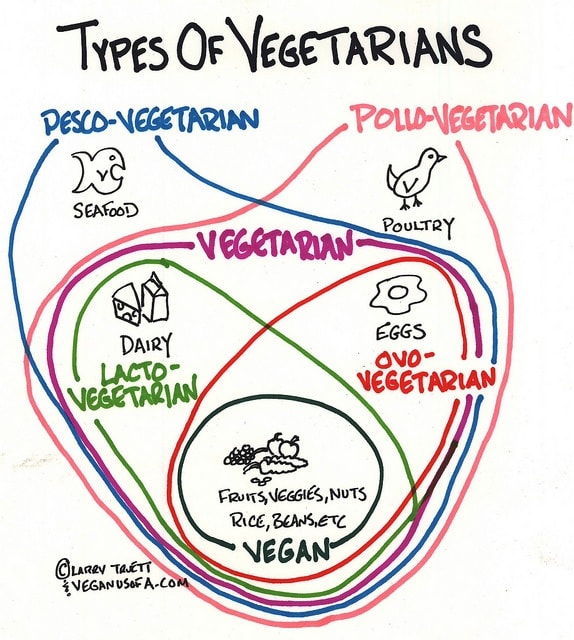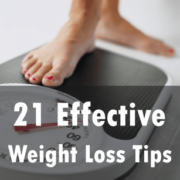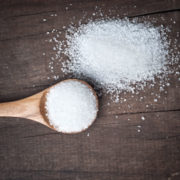Many teens consider some version of a vegetarian life style in high school or college.
There are many reasons for being vegetarian, including the well-being of animals, the health of the planet, and personal health.
As a professional, I endorse their choice, provided they learn how to eat properly to get enough protein, B12, calcium, iron, zinc, and vitamin D, which are important building blocks for health, immunity, and a growing, changing body.
If done correctly, a vegetarian lifestyle can have many long-term health benefits, including reducing the risk of cancer and heart disease, improving weight management, and increasing the probability of overall good health.

If done incorrectly, however, by eating a high carbohydrate, high sugar, low protein, and low vegetable diet, any health benefits are mitigated.
For example, a routine meal plan consisting of grilled cheese sandwiches, white pasta, and lasagna, which is often typical for teens, can lead to unintended and unwelcome weight gain, and increased cholesterol levels just as easily as an unhealthy meat-centered diet.
An important message for teens: in their understandable quest toward better treatment of animals and a healthier, more sustainable planet, it is important to be aware of the way they are treating their own bodies as well! Their own health comes first.
Vegetarian meal plans for teenagers
There are different types of vegetarian meal plans to consider.
Vegan is the most restrictive because it does not allow for any animal products or by-products.
Other types of vegetarian plans include:
- Ovo-vegetarian: includes eggs but not dairy
- Lacto-vegetarian: includes dairy but not eggs
- Ovo-lacto vegetarian: includes both eggs and dairy
- Semi-vegetarian: includes fish and/or free-range poultry
Every one of these diets is similar, except for semi-vegetarian, in that they exclude all forms of meat.
Semi-vegetarians consume fish and/or poultry because they define meat only as “mammalian flesh”, as defined by Wikipedia.

Vegans are nutritionally most at risk because of deficiencies of B12 and vitamin D, which are only found in animal products.
They also have a harder time taking in enough vitamin A, zinc, calcium, and iron.
Vegans, who do not eat dairy products, NEED to consume adequate amounts of leafy greens, sesame seeds, tofu, almonds, and sea vegetables to meet their calcium needs.
Teens choosing the vegan option should consider a good multi-vitamin and mineral complex to get their B12 and vitamin D, as well as other minerals that are less abundant in a plant-based diet.
A subtlety in vegetarian diets is that, though protein is present in vegetable grains and legumes such as beans, they include insufficient amounts of one or more essential amino acids and are thus less efficiently used than protein from animal sources.
Most animal proteins (from meat, fish, poultry, eggs and dairy products) supply a good amount of all of the eight essential amino acids or protein building blocks that must be supplied through the foods we eat.
Animal proteins are therefore called complete proteins because they are balanced and the body can use them ‘as is’ to satisfy protein requirements.
Most proteins from vegetable or grain sources are incomplete, missing one or more essential amino acids.
If a vegetable protein is eaten by itself, the body cannot take full advantage of it as a protein source.
Therefore, it is essential to create a complete protein by combining two incomplete proteins that make up for each other’s amino acid deficiency.
Such combinations are called complementary proteins and can be created by combining legumes and grains, eggs or dairy with any vegetable protein, or legumes with other nuts and seeds.
Recently, a mother of a teenager asked me if her daughter, a recent vegetarian, had to eat vegetables to be considered vegetarian.
I chuckled to myself but the point is valid; a lot of teens just don’t eat many vegetables.

I explained that one of the main elements of a plant- based diet is to eat lots of vegetables to ensure plenty of nutrients and anti-oxidants.
They also provide important fiber which is essential for detoxification and elimination.
There are many ways to prepare vegetables that taste great.
For example, spinach, arugula, broccoli, and kale can be sautéed with garlic, olive oil, and other seasonings which will take away any bitter taste and be truly flavorful.
Another example is roasting vegetables.
An assortment of vegetables, like red pepper, Brussels sprouts, or zucchini, can be baked with garlic and a little drizzled olive oil, salt and pepper on top of them at 400 degrees until soft and delicious.
Vegetables can also be combined with grains and legumes for a healthy complete meal.
For example, chickpeas, black eyed peas and kidney beans can be added to whole wheat pasta, with broccoli and tomatoes, and drizzled with olive oil and spices.
Salad with raw tomatoes, baby spinach, organic baby romaine, green onions, red pepper, green pepper, sliced almonds, cashews, and strawberries topped lightly with olive oil or low fat natural dressing is a great way to get 3-4 servings of vegetables in a meal.
In summary, a vegetarian lifestyle can be healthy, provided it is balanced with enough protein, whole grains, healthy fat, fruits, and vegetables to provide enough vitamins, minerals, protein, and other important building blocks for growth, development, immunity, and overall well-being.
With proper planning and a willingness to try new healthy foods, young vegetarians can combine their interest in protecting animals with choosing meals that will promote good health for years to come.
Following are options and references to assist new vegetarians on a road to success:
Dietary Tips
Vegetarian Protein Sources – Legumes, grains, soy products, meat analogues, and nut butters are all concentrated protein sources.
Eggs, low-fat dairy, and fish are also good sources of protein for vegetarians who continue to eat these foods.
Calcium – The best sources of non-dairy calcium include: green leafy vegetables (including collard greens, mustard greens, bok choy, broccoli, kale), tofu, almonds, and tahini, also certain seaweeds and calcium-fortified soy milk and orange juice.
Iron – The best vegetarian sources of iron are broccoli, raisins and other dried fruit, watermelon, spinach, black-eyed peas, chickpeas, and pinto beans.
Zinc – The best vegetarian sources of zinc are peas, lentils, wheat germ, and pumpkin seeds.
Omega 3s – The best vegetarian sources of omega 3s are walnuts and flaxseeds, adding wild salmon and sardines for fish-eaters.
B12 – Nutritional yeast, substitute meats, and soy milk are also often fortified with B vitamins.
Vitamin D – Sunlight is best, but it can also be found in dairy and fortified dairy substitutes.
Breakfast Ideas
There are many healthy low sugar cereals, such as Puffins (which are gluten-free) and Kashi, as well as a variety of granolas, whole wheat, bran, and grain cereals on the market.
Read more: 7 Gluten-Free Grains
Enjoying them with low fat hormone-free milks or fortified soy milk with a handful of nuts makes an easy, balanced breakfast.
Hot cereals: There are many and varied hot cereals options available – everything from flax to multigrain oats to cream of whole wheat.
Again check the ingredients. If the product contains lots of sugars and unpronounceable ingredients, it’s not good for your health.
Also, note the protein content since it can vary widely.
Adding skim, almond, or soy milk and ground flax seeds, raisins, and crushed walnuts or almonds will make the cereal more nutritious.
Adding protein powder to ensure enough protein at each meal is also an option.
Low sugar Greek yogurt or low-fat cottage cheese with banana, apple, or fruit of choice is another easy breakfast.
Whole grain toast with nut butter or toast with scrambled tofu or eggs is also very balanced. You can try adding broccoli, red and green peppers, mushrooms, and onions to eggs for added vegetables. Scrambled tofu tastes especially good when spiced with cumin, thyme, paprika, and turmeric (a recipe can be found at theppk.com).
Quick and healthy meals for teenagers
Peanut or other nut butters on whole grain bread. Try a grilled cashew butter and red banana sandwich with honey.
Stirfry any vegetables you like sautéed in olive oil. Add tempeh, tofu or seitan, and just a little teriyaki, soy, or other sauce of choice and serve over brown rice.
Grilled tofu sandwich – The Bridge makes all natural homemade local tofu (available at Whole Foods and Nature’s Temptations). The texture and taste are both appealing and make for an excellent sandwich filler. Add lettuce, tomatoes, sprouts, and mustard or other condiment.
Brown rice and beans
Canned organic bean soups and chili (Read the ingredients because some are high in sodium.)
Veggie dogs or burgers, meatless organic sausages, chickenless chicken (Whole Foods has an impressive selection of natural meat alternatives)
Healthy snacks for teens
Baby carrots or other cut up veggies with hummus or bean dip
Cereal (Kashi Go Lean crunch is one of my favorites) as trail mix with mixed nuts
Homemade or store bought granola, raw nuts, fresh cut veggies or fruit.
Easy recipe: How To Make Homemade Granola Bars
Bean soups – Amy’s brand makes some good organic ones.
Primal strips (vegan jerky snacks which can be found at Whole Foods)
Meal and energy bars – Check the nutritional informational on the packages since many are high not only in protein but also in processed sugars and fat. Go Macro makes some excellent tasting ones that are sweetened with organic agave nectar and tend to be high in fiber.
Raw nuts with fresh fruit
Animal by-products – If you want to avoid animal by-products, be aware of the following: animal products include gelatin, oleic acid, lard, pepsin, (an enzyme from pig’s stomach), rennin (enzyme found in the stomachs of baby animals used to curd some types of cheeses).
For a more extensive list, go to: Happycow.net or Cyberparent.com
Other ingredients that do not involve animal bi-products, but are bad for health and should be minimized, include: corn syrup, high fructose corn syrup, sodium nitrate, monosodium glutamate (MSG) and hydrogenated fats.
Further reading
I hope I’ve covered the basics of vegetarian lifestyle for teenagers topic. If you want to read further, I recommend the following books:












